Analysis reveals substantial difference between the PA’s reported and actual expenditure on civil servant salaries.
By Maurice Hirsch, Adv., Palestinian Media Watch
According to a recent European Union report, “Since 2008, the European Union, Norway, and Switzerland have provided over 14 billion dollars in official development assistance to the Palestinian Authority and the Palestinians.”
As part of the continued aid, the EU recently finalized a new 296 million euro aid package for the PA and the Palestinians for 2023. In the press release following the ceremony announcing the newest EU aid package to the PA, the EU noted: “To that end 114.2 million EUR will support the Palestinian Authority in the payments of the salaries and pensions of civil servants, the social allowances to vulnerable families and the referrals to the East Jerusalem Hospitals.”
Since a considerable amount of the EU aid to the PA is spent on paying the “salaries and pensions” of the PA civil servants and on the backdrop of the PA teachers strike that has continued on since February 5th, Palestinian Media Watch decided to zoom in on the subject of the PA salaries to its civil servants since 2016.
The results of the examination shows a huge difference between the sum the PA reports to the world that it paid its civil servants and the sum PMW calculated to be the actual PA expenditure based on the PA’s own published labor reports.
PMW’s findings indicate, that in most years, there is a substantial difference between the PA reports – some years over a billion shekels – a sum which is even greater than the aid the PA received from the EU in that year.
For example, in 2022, according to the PA’s budget performance reports, the PA claimed to have paid its civil servants a cumulative sum of 8,114,105,436 shekels. However, according to the PA’s labor reports, the actual sum the PA paid to its civil servants was closer to 6,881,372,495 shekels, leaving a difference of 1,232,732,941 shekels or €302,374,788.
Since the EU is providing substantial aid to the PA, and wants to know exactly where every euro is spent, the question that the EU accountants/economists should be asking themselves is where is that aid money really going?
Methodology
To conduct the examination, PMW looked at two central PA publications.
On the one hand, PMW examined the monthly budget performance reports published by the PA Ministry of Finance.
As part of an agreement to receive funding from the World Bank, since 2008 the PA has been required to publish a range of financial documents, including its annual budget and monthly budget performance reports.
While the PA has not published an annual budget since 2018 and has occasionally tried to hide its budget performance reports, as PMW has repeatedly exposed, as a general rule, when available, the budget performance reports are meant to provide the international community with the ability to assess the PA’s monthly and annual income and expenditure.
In these reports, the PA provides, inter alia, a total of the PA’s monthly and annual expenditure on “Wages and salaries” paid to all the PA civil servants in all the different PA ministries and branches. The following is an example of an expenditure table that appeared in the PA’s Dec. 2022 budget performance report:
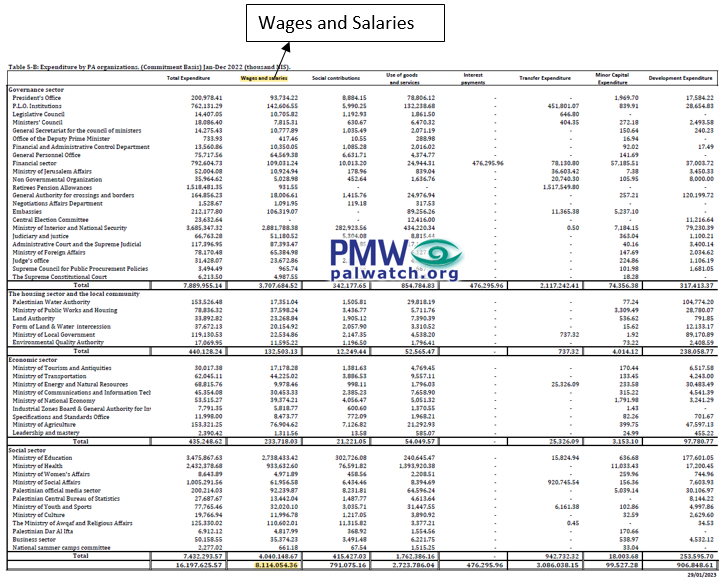
The end of the table shows, that the PA claims to have paid its civil servants, in 2022, a cumulative sum of 8,114,054,360 shekels (as the note at the top of the chart explains, the sums that appear in the charts are in thousands)
On the other hand, PMW examined quarterly “Labour Force Survey”s published by the PA Central Bureau of Statistics.
In these reports, the PA provides detailed statistical information regarding the participation of Palestinians in the Palestinian labor market. As opposed to the budget performance reports, which are meant, ostensibly, to be able to provide decision-makers with a general overview of the PA’s finances, the “Labour Force Surveys” provide detail-focused statistics on a wide range of different Palestinian employment-related subjects. These reports are designed to support more exact financial analysis.
Among the many other employment indicators, the “Labour Force Surveys” provide statistics about the entire number of Palestinians who are employed, with a division in percentages, of those employed in the private and public (PA civil servants) sectors. Additionally, the “Labour Force Surveys” also provide information on the average daily/monthly salaries paid by the different employers, including details of the sums the PA pays to its civil servants.
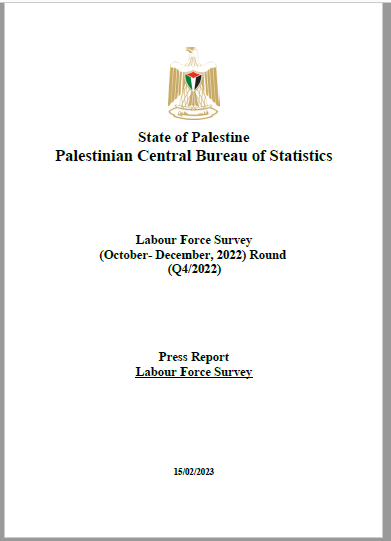
The October-December 2022 report, for example, included the following chart, showing that during that period, 1,158,800 were employed:
Chart 1
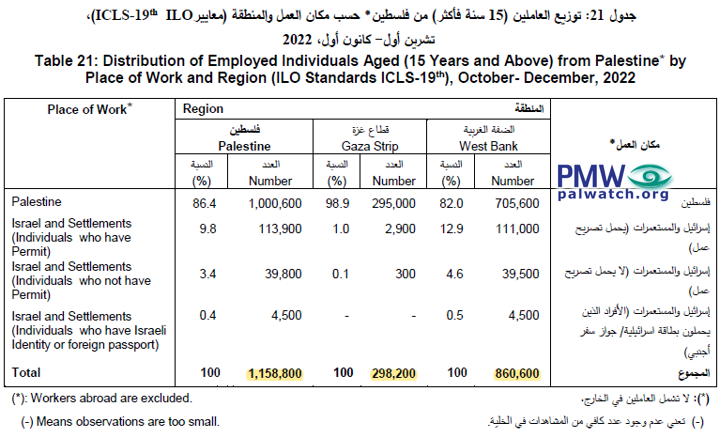
A different chart included in the report, showed the division of the employed Palestinians by employer, and said that 17.9% of the employed Palestinians worked for the PA:
Chart 2
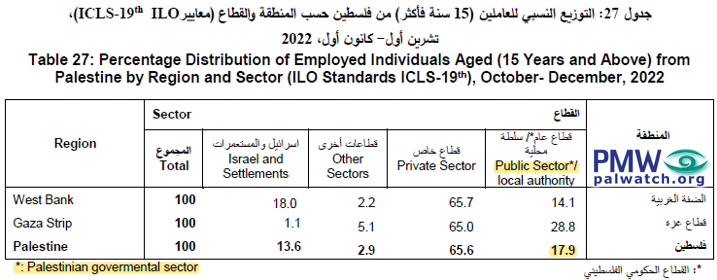
An additional chart included in the report, showed the average daily wage earned by the employed Palestinians by region and sector, including the civil servants.
Chart 3

A final chart showed that on average, the employed Palestinians worked 22 days every month:
Chart 4

Based on these extensive statistics, PMW was able to make relatively accurate calculations as follows:
–First, using charts 1 and 2 above, PMW calculated the number (as opposed to the percentage) of Palestinians employed by the PA. If there are 1,158,800 employed Palestinians (chart 1), and 17.9% of them work for the PA (chart 2), that means there are, approximately, 207,425 Palestinians employed by the PA (of them approximately 121,345 are employed by the PA in the West Bank and 85,882 in the Gaza Strip.)
–Next, using the figure of the number of Palestinians employed by the PA, multiplied by the average daily wage the PA reported it paid the PA civil servants (chart 3), 120.2 shekels, and then multiplying the daily wage expense by the number of working days in the year PMW was able to calculate the annual PA expenditure on the wages of its civil servants:
(207,425 (civil servants) x 120.2 (shekels average daily wage)) x 264 (working days per year) = 6,582,182,387 shekels/year
As can be seen, this figure, based on detailed statistics provided by the PA itself, is significantly lower, than the figure the PA, in its budget performance report, claimed it had paid to its civil servants – i.e. 8,114,054,360 shekels.
By repeating this calculation process for the years 2016, 2018, 2019, 2020, and 2021 (similarly using the PA’s end-year (December) budget performance reports, combined with the annual October-December “Labour Force Survey” report), PMW was able to calculate the difference between the sum the PA reported (in its budget performance reports) that it had paid its civil servants, and the sum the PA had actually paid its civil servants (based on the detailed Labour Force Surveys). The results of those calculations appear in this chart:
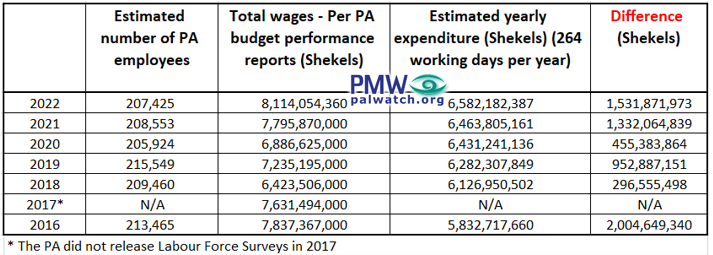
The difference
As the calculations clearly show, there appears to be a substantial difference between the PA’s reported expenditure on the salaries of its civil servants that it provides in the overview budget performance reports, as opposed to the calculated expenditure based on the PA’s own detailed labor force participation reports.
Since 2016, the smallest difference appears to have been in 2018, when it was limited to circa 296 million shekels (€72.7 million). In 2020, the year of the COVID-19 crisis, the difference appears to have been 455 million shekels (circa €111.6 million). In the years 2016, 2019, 2021 & 2022, the difference was inexplicably between 900 million – 2 billion shekels (circa €220.8 million – €490.6 million).
Some of the questions that need to be asked
While the PA constantly begs the world for donations, it fails to provide even basic financial transparency. At the moment, as PMW recently exposed, the PA has removed from the internet even the limited financial information it had been providing. The PA allows itself to hide its financial situation, since the international community, particularly the EU, seems to accept blindly the claim that the PA is suffering financial hardship.
The first question therefore, is why does the international community not demand full, openly available, financial transparency as a non-negotiable precondition to even considering aid requests?
The differences identified above regarding the PA expenditure, show that the financial reports published by the PA do not correlate with one another. Since the Labour Survey reports ostensibly provide detail-based analysis, which in turn provide international agencies, such as the World Bank and other financial institutions, with the basis for their reports, it would seem that greater weight should be given to these reports than the PA budget performance reports. On the other hand, it would also seem that the PA has an interest to use its detail-based statistics to present a picture bleaker than the reality.
The question therefore, is which of the PA’s financial reports are truly accurate? How does the PA explain the contradictory reports?
While reports of “irregularities” regarding the number of PA employees are not new, the PA does not publish an accurate number of PA employees. The numbers that have been published, clearly demonstrate the questionable PA practices. For example, as PMW exposed, during the years 2013 – 2017 the number of high-ranking officers in the PA security forces grew at a completely disproportionate rate to the number of non-officers. The statistics also showed that there are more officers ranked Major-General in the PA security forces than in the entire Israeli security forces.
Accordingly, the question is how many people are actually employed by the PA and in what positions? How many teachers, doctors, policemen etc. etc. etc. does the PA have? What are the PA pay scales?
As regards the PA teachers, the situation would seem quite acute. While the EU consistently donates aid to participate in the payment of salaries to the teachers, as PMW exposed, for the last 3 months thousands of teachers have been on strike, complaining about the fact that they are not receiving their full remuneration.
The question therefore, is who is monitoring what happens with the aid the EU provides to the PA? How often does the EU conduct in-depth audits to see exactly where the EU aid is going? Do those audits include an examination of the PA’s wider budgetary expenses to identify situations in which the fungibility of money allows the PA to use its own income for malfeasances, such as paying huge financial rewards to incentivize, promote and reward terror, while the EU shoulders the burden of paying the legitimate PA employees, or does the audit simply confirm that the EU money is ostensibly being paid? Donate to vital charities that protect Israelis and help inspire millions around the world to support Israel too! Now more than ever, Israel needs your help to fight and win the war -- and also the battle of public opinion. Anti-Israel bias and boycotts are out of control. Israel's enemies effectively use social media to incite brutal terror against innocent Israeli civilians. Please help us fight back! HELP DEFEND THE TRUTH - MAKE A DONATION TODAY
Do You Love Israel? Make a Donation to Show Your Support!




